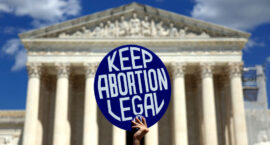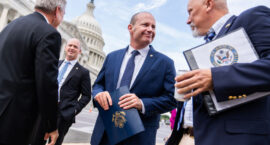In June, Mexico marked a historic moment electing its first female president. Many women from the United States and other Latin American countries travel to Mexico to seek care. Therefore, advancing reproductive choice for women and girls should be a top policy priority for President Claudia Sheinbaum’s term in order to expand access to myriad opportunities for women across the Americas.
Category: Justice & Law
House Republicans Are Jeopardizing the Rights of Women and LGBTQ+ Students
On April 19, the Biden administration released new Title IX guidelines that increase protections for assault victims, LGBTQ+ students, and pregnant students by providing schools more flexibility in how they conduct investigations.
Almost three months later, on July 10, House Republicans passed a Congressional Review Act (CRA) resolution—House Joint Resolution 165—that would block the Biden administration’s Title IX revisions and revert them back to the restrictive Trump-era Title IX guidelines.
Gen Z’s Fight to Secure the ERA in the Constitution
Women are still fighting for the ERA and constitutional gender equality. It’s astonishing that in 2024, women are not legally considered equal to their male counterparts.
For Gen Z, a generation that prides itself on embracing diversity, inclusion and equality, this discrimination cannot stand. We are in a unique position to support gender equality, demanding that it becomes a constitutional right.
Republican National Platform Invites Nationwide Abortion Ban by Supreme Court Decree
To give themselves political cover in the fall elections, conservatives have devised a way to sidestep democratic processes and political accountability while still achieving a nationwide abortion ban. They hope to do this by asking the conservative supermajority on the Supreme Court to interpret the 14th Amendment to ban abortion nationwide. In other words, they don’t need a new amendment because they assert the Constitution already bans abortion.
Tradwives Are Doing Conservatives’ Work for Them
Project 2025 paints a picture of a future where all American women are tradwives.
The 22 Scariest Lines We Found in Project 2025’s 900-Page ‘Mandate for Leadership’
Project 2025, the extremist blueprint for the next Republican president, maps out the permanent reversal of more than 50 years of gains for American women and LGBTQ+ people. The authors of Project 2025—80 percent of whom served in the first Trump administration—paint a picture of a nation where women are fundamentally second class citizens.
Project 2025 contains an 887-page policy agenda. We read the whole thing, so you don’t have to. Here are the most terrifying things we found.
Judge Aileen Cannon Does Trump’s Bidding in Dismissing Mar-a-Lago Case
Monday was a day bookended by reminders that Donald Trump expects and rewards obedience—from Cannon’s Florida ruling, to Trump’s VP pick of JD Vance.
JD Vance, Trump’s VP Pick, Has Opposed Abortion and LGBTQ+ Rights
Former President Donald Trump has selected as his running mate Sen. JD Vance of Ohio, who has opposed abortion rights and LGBTQ+ rights in his time in political office.
Vance, who ran as staunchly anti-abortion in his Senate campaign and in 2021 compared abortion to slavery, has somewhat shifted his public stance on the issue. Trump has reportedly viewed a hardline stance on abortion as a negative for a running mate.
On the campaign trail in 2021, Vance defended the lack of exceptions for rape and incest in a Texas abortion ban known as S.B. 8, saying in an interview that “two wrongs don’t make a right.” In a July 2021 interview with Fox News, he criticized “the childless left,” saying, “Why have we let the Democrat Party become controlled by people who don’t have children?” In June, Vance voted against a Democratic-led bill to enshrine access to in vitro fertilization (IVF).
Will Divorce Be the Next GOP Target Against Women?
For many women, divorce means escape. Right-wing Republicans like JD Vance and Mike Johnson are targeting it.
Vance said leaving “unhappy or even violent” marriages “didn’t work out for the kids,” suggesting that people trapped in violent marriages should stay in them to preserve family stability. You know what’s worse for children than divorce? Domestic violence.
Republicans Want to Reverse Over a Half-Century of Hard-Fought Progress for Women and Girls
The women and girls of Afghanistan are in my thoughts lately, as the recently released U.N. special rapporteur’s report sheds light on the devastating impact of the Taliban’s gender apartheid regime in the time since they came back to power. Women and girls in the country are living under a brutal system of gender apartheid, experiencing the “deliberate systematized step-by-step eradication of their rights and freedoms.”
And to be honest, it seems like the right wing in America is trying to push women in this country in the same direction. Just look at their policy objectives outlined in Project 2025—a roadmap for a Republican presidency that would reverse over a half-century of hard-fought progress for women and girls.












